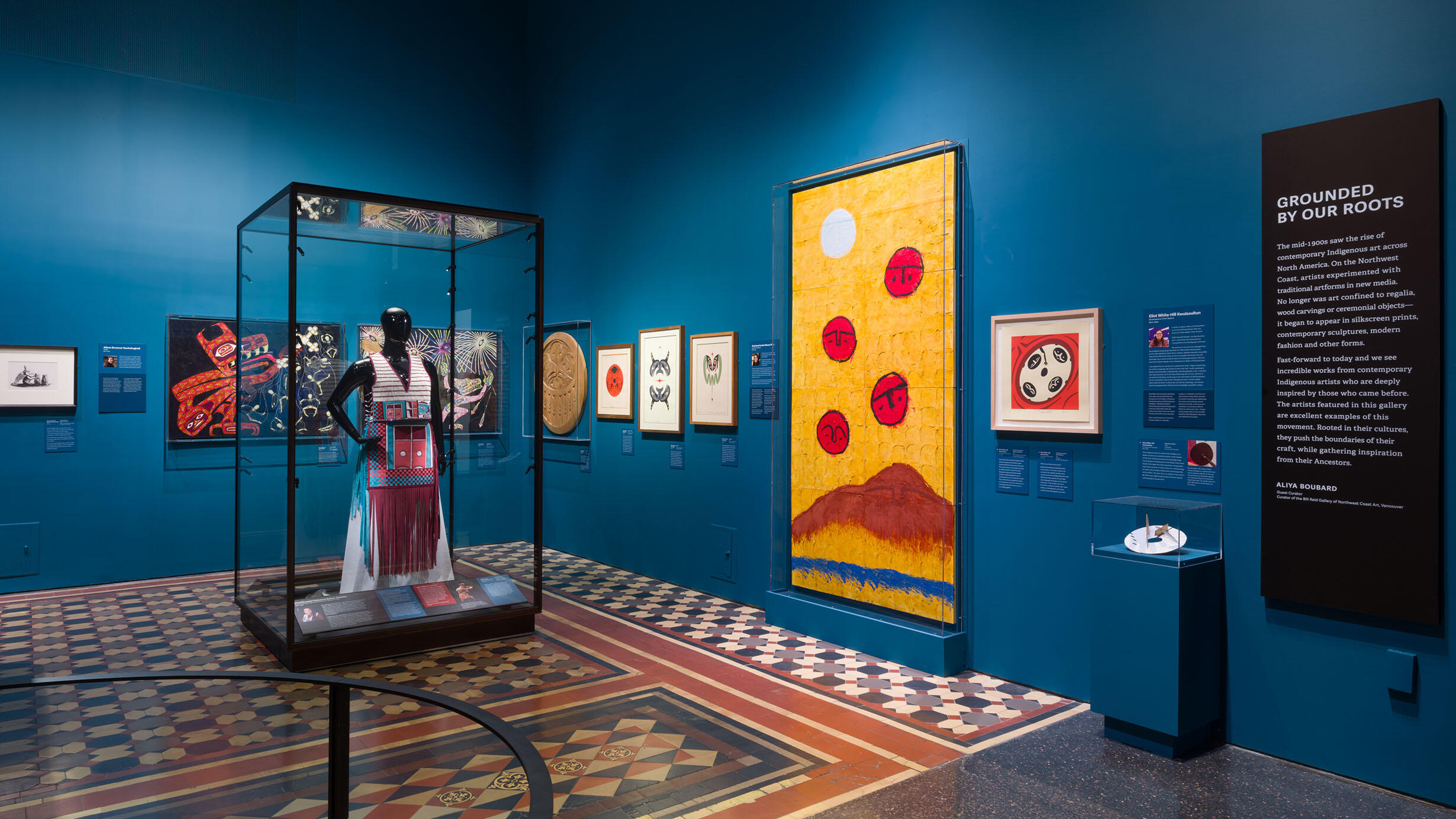Grounded by Our Roots, A New Indigenous Art Exhibition, Opens at AMNH
 Grounded by Our Roots, an exhibition of 13 extraordinary works by up-and-coming Indigenous artists who draw inspiration from their cultural traditions, opens to the public on April 3 in the rotating contemporary art gallery of the Northwest Coast Hall at the American Museum of Natural History.
Grounded by Our Roots, an exhibition of 13 extraordinary works by up-and-coming Indigenous artists who draw inspiration from their cultural traditions, opens to the public on April 3 in the rotating contemporary art gallery of the Northwest Coast Hall at the American Museum of Natural History.Alvaro Keding/© AMNH
Grounded by Our Roots, an exhibition of 13 extraordinary works by up-and-coming Indigenous artists who draw inspiration from their cultural traditions, opens to the public on April 3 in the rotating contemporary art gallery of the Northwest Coast Hall at the American Museum of Natural History. The exhibition is produced with guest curator Aliya Boubard, the curator of the Bill Reid Gallery of Northwest Coast Art in Vancouver, who is Anishinaabe and a member of Sagkeeng First Nation in Manitoba.
“We are thrilled to present the exquisite works of five emerging artists in the contemporary art gallery in the Northwest Coast Hall,” said Museum President Sean M. Decatur. “Grounded by Our Roots beautifully showcases the vibrancy, brilliance, and creativity of Indigenous art today and reflects the powerful connections of Native artists with their ancestral traditions. The Northwest Coast Hall was designed to incorporate special temporary exhibits like this one as part of our commitment to ensuring that contemporary Native art and perspectives are always part of the hall.”
“The mid-1900s saw the rise of contemporary Indigenous art across North America. On the Northwest Coast, artists experimented with traditional artforms in new media. No longer was art confined to regalia, wood carvings or ceremonial objects—it began to appear in silkscreen prints, contemporary sculptures, modern fashion, and other forms,” said Boubard. “Fast-forward to today, and we see incredible works from contemporary Indigenous artists who are deeply inspired by those who came before. The artists featured in this gallery are excellent examples of this movement. Rooted in their cultures, they push the boundaries of their craft, while gathering inspiration from their Ancestors.”
The artists and works featured in the gallery are:
Hawilkwalał Rebecca Baker-Grenier (Kwakiuł, Musgamagw Dzawada’enuxw, Sḵwx̱wú7mesh), a fashion designer who debuted her first collection at New York Fashion Week in 2022 and sees “fashion as a living practice that is rooted in our art form, laws, and worldview”
- Held by Generations (2023/2024): a vest and skirt made from dentalium shells, ermine, glass beads, leather, and cotton that merge ancestral materials and designs with contemporary style as an outward representation of the artist’s identity
Alison Bremner Naxhshagheit (Tlingit), who works in woodcarving, painting, digital collage, among other media, “exploring the present-day Tlingit experience, each concept ultimately dictating the medium”
- Midnight at the Fireworks Stand (2022): an acrylic painting made on vintage and found wallpaper focused on Indigenous communities that are heavily affected by generational trauma inflicted from Western contact
- Church and State (2024): an acrylic painting on canvas born of frustration with the Supreme Court’s authority to govern Indigenous matters
SGidGang.Xaal Shoshannah Greene (Haida), who studied hand-drawn animation before switching to classical and contemporary Haida formline and “love(s) to explore and play between the worlds of classical formline and contemporary mediums”
- Shines Like Gold (2022): an archival pigment print on cotton rag that is inspired by Haida argillite plates. This piece refers to the story of Nang Kilslaas (also known as Raven), after he has successfully stolen the light that was concealed.
- Nang Kilslaas and The First Xaaydas (2023): an illustration on cotton archival watercolor paper that is one of several pieces from the project Our Guiding Ways of Being, a series of traditional and contemporary stories focused on Haida beliefs and values
Nash’mene’ta’naht Atheana Picha (Kwantlen First Nation), whose work is “focused on learning traditional Coast Salish design language and studying Northwest Coast artwork with the introduction of different material practices”
- Split Serpent (2023): a serigraph on Stonehenge paper inspired by the artist’s effort to overcome a fear of snakes
- Thunderbirds and Serpents (2022), a serigraph on Stonehenge paper whose design is a study in Coast Salish forms
- Navigators (2022), a serigraph on Stonehenge paper, which the artist made after research into Nuu-chah-nulth and Coast Salish printmakers
- Thunderbird’s Visit (2023), a cedar carving that is a reflection of Coast Salish spindle whorls, which are recognized as the “teachers” of contemporary Coast Salish visual design
Eliot White-Hill Kwulasultun (Snuneymuxw First Nation), an interdisciplinary artist who aims to “share our art and our teachings, and ensure that future generations will have that knowledge accessible to them”
- Ancestors' Hands (2022): a cardboard sculpture made of a pizza box that is part of a series centered around an archaeological dig that took place in Snuneymuxw First Nation (Vancouver Island) in the 1980s
- We Fell From the Sky / Together and Apart (2022): mixed media on birch panel that tells one of the creation stories of the Snuneymuxw First Nation, whose ancestors fell from the sky onto Te’tuxwtun
- Through the Spindle / Other Whorlds (2021): a serigraph that explores the concept of the sulsultun (spindle whorl), a sacred source of knowledge within the Coast Salish world
The Museum’s Northwest Coast Hall reopened in 2022 following a transformative renovation and reinterpretation in consultation with Indigenous communities from the Pacific Northwest Coast. As part of the revitalization, a rotating art gallery was created to showcase the continuity and transformation of Indigenous creative traditions. Grounded by Our Roots will follow the inaugural exhibition, Living with the Sea, which explored the significance of the ocean to Northwest Coast Native peoples. The curator of the Northwest Coast Hall is Peter Whiteley, curator of North American Ethnology at the Museum, and the co-curator is Ḥaa’yuups, Nuu-chah-nulth scholar and cultural historian.